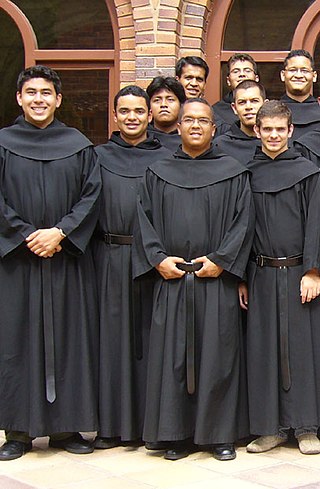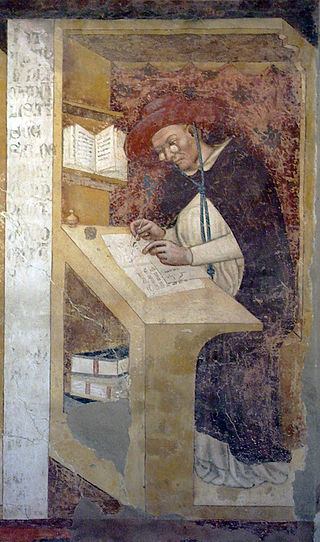Related Research Articles

The Order of the Brothers of the Blessed Virgin Mary of Mount Carmel, known as the Carmelites or sometimes by synecdoche known simply as Carmel, is a Roman Catholic mendicant religious order for men and women. Historical records about its origin remain uncertain, but it was probably founded in the 12th century on Mount Carmel in the Crusader States. Berthold of Calabria, as well as Albert of Vercelli, have traditionally been associated with the founding of the order, but few clear records of early Carmelite history have survived. The order of Carmelite nuns was formalised in 1452.

Augustinians are members of several religious orders that follow the Rule of Saint Augustine, written in about 400 AD by Augustine of Hippo. There are two distinct types of Augustinians in Catholic religious orders dating back to the 12th–13th centuries:

A friar is a member of one of the mendicant orders of the Roman Catholic church. The term, first used in the 12th or 13th century, distinguishes the mendicants' itinerant apostolic character, exercised broadly under the jurisdiction of a superior general, from the older monastic orders' allegiance to a single monastery formalized by their vow of stability. A friar may be in holy orders or be a brother. The most significant orders of friars are the Dominicans, Franciscans, Augustinians, and Carmelites.

The Scapular of Our Lady of Mount Carmel belongs to the habit of both the Carmelite Order and the Discalced Carmelite Order, both of which have Our Lady of Mount Carmel as their patroness. In its small form, it is widely popular within the Latin Church of the Catholic Church as a religious article and has probably served as the prototype of all the other devotional scapulars. The liturgical feast day of Our Lady of Mount Carmel, July 16, is popularly associated with the devotion of the Scapular.

Mendicant orders are, primarily, certain Roman Catholic religious orders that have adopted for their male members a lifestyle of poverty, traveling, and living in urban areas for purposes of preaching, evangelization, and ministry, especially to the poor. At their foundation these orders rejected the previously established monastic model. This model prescribed living in one stable, isolated community where members worked at a trade and owned property in common, including land, buildings and other wealth. By contrast, the mendicants avoided owning property at all, did not work at a trade, and embraced a poor, often itinerant lifestyle. They depended for their survival on the goodwill of the people to whom they preached. The members of these orders are not called monks but friars.
Albert of Jerusalem, also Albertus Hierosolymitanus, Albertus Vercelensis, Saint Albert, Albert of Vercelli or Alberto Avogadro, was a canon lawyer and saint. He was Bishop of Bobbio and Bishop of Vercelli, and served as mediator and diplomat under Pope Clement III. Innocent III appointed him Patriarch of Jerusalem in 1204 or 1205. In Jerusalem, he contributed the Carmelite Rule of St. Albert to the newly-founded Carmelite Order. He is honoured as a saint in the Roman Catholic Church and commemorated by the Carmelites on 17 September.

Hugh of Saint-Cher, O.P. was a French Dominican friar who became a cardinal and noted biblical commentator.

Angelus of Jerusalem, OCarm was a Catholic convert from Judaism and a professed priest of the Carmelites. He and his twin brother became converts to the faith following their mother's conversion. Both went on to become ordained priests and Carmelite friars. Unlike his brother, however, he retreated into the desert to a hermitage after his ordination, but he emerged once he was instructed to go to the Italian mainland to evangelize as well as to meet with Pope Honorius III to have him approve a new rule for the Carmelites.

Our Lady of Mount Carmel, or Virgin of Carmel, is the title given to the Blessed Virgin Mary in her role as patroness of the Carmelite Order, particularly within the Catholic Church. The first Carmelites were Christian hermits living on Mount Carmel in the Holy Land during the late 12th and early to mid-13th century. They built in the midst of their hermitages a chapel which they dedicated to the Blessed Virgin, whom they conceived of in chivalric terms as the "Lady of the place." Our Lady of Mount Carmel was adopted in the 19th century as the patron saint of Chile.

Simon Stock, OCarm was an English Catholic priest and saint who lived in the 13th century and was an early prior of the Carmelite order. The Blessed Virgin Mary is traditionally said to have appeared to him and given him the Carmelite habit, the Brown Scapular. Thus, popular devotion to Stock is usually associated with devotion to Our Lady of Mount Carmel.

Consecrated life is a state of life in the Catholic Church lived by those faithful who are called to follow Jesus Christ in a more exacting way. It includes those in institutes of consecrated life, societies of apostolic life, as well as those living as hermits or consecrated virgins/widows.

The Discalced Carmelites, known officially as the Order of the Discalced Brothers of the Blessed Virgin Mary of Mount Carmel or the Order of Discalced Carmelites, is a Catholic mendicant order with roots in the eremitic tradition of the Desert Fathers. The order was established in the 16th century, pursuant to the reform of the Carmelite Order by two Spanish saints, Teresa of Ávila (foundress) and John of the Cross (co-founder). Discalced is derived from Latin, meaning "without shoes".

Berthold of Calabria was a Calabrian crusader and saint who established a hermit colony on Mount Carmel in 1185. He was introduced into Carmelite literature around the 15th century as Saint Berthold of Mount Carmel and is said to have been a general of the Order before Brocard.

The Carmelite Monks or Monks of the Most Blessed Virgin Mary of Mount Carmel are a public association within the Diocese of Cheyenne, dedicated to a humble life of prayer. The Wyoming Carmelites claim loyalty to the Magisterium of the Catholic Church and to the Carmelite charism. Their life includes strict separation from the world and the living of the cloistered Carmelite spirituality and way of life established by John of the Cross and Teresa of Jesus. In accord with the Carmelite Rule, they engage in manual labor and the study of Carmelite spirituality in the solitude of the mountains, with the firm hope of attaining to Union with God.
The Book of the First Monks is a medieval Catholic book in the contemplative and eremitic tradition of the Carmelite Order, thought to reflect the spirituality of the Prophet Elijah, honored as the Father of the Order.

Brocard is said to have been one of the first leaders of hermits at Mount Carmel, and was perhaps the leader of the community on the death of Berthold of Calabria around 1195. Various details of his life are legendary.

The Secular Order of Discalced Carmelites, formerly the Secular Order of Discalced Carmelites of the Blessed Virgin Mary of Mount Carmel and of the Holy Mother Saint Teresa of Jesus, is a third order of Catholic lay persons and secular clergy associated with the Discalced Carmelites.

The Stella Maris Monastery is a Catholic Christian monastery for Discalced Carmelite monks, located on the slopes of Mount Carmel in Haifa, Israel.
"A religious institute is a society in which members, according to proper law, pronounce public vows, either perpetual or temporary which are to be renewed, however, when the period of time has elapsed, and lead a life of brothers or sisters in common."
The Hermits of the Most Blessed Virgin Mary of Mount Carmel is a branch of the Carmelite Order of the Ancient Observance, who originated as hermit monks and have been mendicant friars since the 13th century.
References
- ↑ Michael Ott, "Pope Honorius III", The Catholic Encyclopedia, Volume 7 (New York: Robert Appleton Company, 1910)
- ↑ Bl. Titus Brandsma on the 'Spirituality of the Carmelites of the Ancient Observance'
- ↑ Land of Carmel By Elizabeth Ruth Obbard
- ↑ Catholic Encyclopedia Entry of "The Carmelite Order"